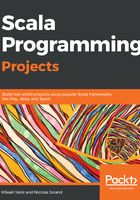
What this book covers
Chapter 1, Writing Your First Program, explains how to set up your environment to start programming in Scala, covering the basic tools that are required and what the simplest Scala application might look like.
Chapter 2, Developing a Retirement Calculator, puts into practice the features of the Scala language seen in the first chapter. We will also introduce other elements of the Scala language and SDK to develop the model and logic for a retirement calculator. This calculator will help people work out how long they'll need to save and how much they'll need to save to have a comfortable retirement.
Chapter 3, Handling Errors, has you continuing to work on the retirement calculator from the previous chapter, handling the errors that riddle it. For instance, the calculator works correctly as long as the right arguments are passed to it but fails badly with a horrible stack trace if any of the parameters are wrong.
Chapter 4, Advanced Features, explores the more advanced features of Scala. As with any programming language, some advanced constructs might be seldom used in practice or can obfuscate code. We will aim to only explain features that we have encountered in real projects that have been deployed to production.
Chapter 5, Type Classes, you will learn what a type class is, what are the most common type classes in the cats library, and how to use them in your projects.
Chapter 6, Online Shopping – Persistence, explains how to persist data in a relational database. The data will be the contents of a cart for a shopping website.
Chapter 7, Online Shopping – REST API, covers how to develop a REST API using Play Framework. API is an acronym for Application Programming Interface, and the acronym REST stands for Representational State Transfer. Basically, we will provide an interface for our application, so that other programs can interact with it.
Chapter 8, Online Shopping – User Interface, gets you using Scala.js to build the user interface for the online shopping application. In this interface, you will be able to select a product to add to your cart, update the number of products that you wish to buy, and remove them from the cart if needed.
Chapter 9, Interactive Browser, introduces the actor model by extending our shopping project. The extension will consist of a notification, provided to anyone connected to the website, about who is adding/removing a product to/from the cart.
Chapter 10, Fetching and Persisting Bitcoin Market Data, look at developing a data pipeline to fetch, store, and analyze Bitcoin transaction data. We will use Apache Spark in batch mode to do so.
Chapter 11, Batch and Streaming Analytics, focuses on how to use Zeppelin and Spark to query our historical data store. We will use Zeppelin's capability to plot interesting graphs and Apache Kafka with Spark streaming to analyze live transactions.